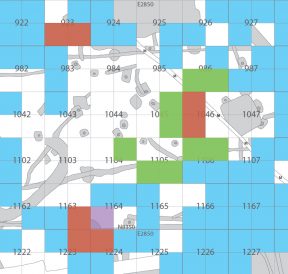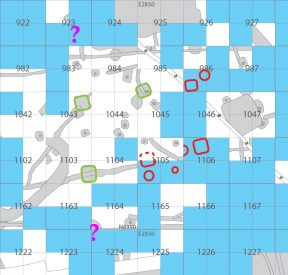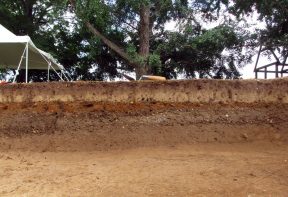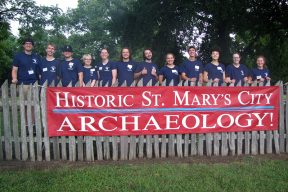Back to Dispatches from Field School
Field School 2018 – Week 10
Travis Parno — Director of Research and Collections
“The Conclusion of the 2018 Field School”
Once again, our ten-week program has flown by and we find ourselves at the conclusion of the 2018 Field School in Historical Archaeology. It has been a very productive summer, one that featured plenty of discoveries along with relatively moderate temperatures and a fair share of rain. We’ve troweled and re-troweled features, screened hundreds of buckets of soil, and dug through plenty of gravel. I’m so proud of our students, all of whom weathered the summer admirably and learned a great deal about historical archaeology at Maryland’s first capital.

Map showing units worked on during the 2018 season. Green units are completed, red are in-progress, and purple were unbackfilled.
At the end of a summer such as this, I find myself revisiting our goals that were set at the summer’s outset (read more about our plans here). To review, our focus was directed towards the north yard of the Leonard Calvert House site. There we aimed to understand a cluster of postholes that have been identified in past seasons of excavations at the site. In particular, we hoped to link larger, structural postholes together to determine if an outbuilding (e.g., storehouse, barn, auxiliary kitchen) once stood in our target area of interest.
In pursuit of this objective, we opened a total of 16 new excavation units in various locations throughout the north yard. Seven of those units are still in-progress; we will be returning to the field next week to continue working on them. We also unbackfilled one unit in our target area.
Throughout our excavations, the field team spent a lot of time digging through the hard-packed gravel driveway that used to lead up to the Brome-Howard House. Our students quickly learned how challenging it is to work through such compacted material! But they excavated through the gravel and the results were quite wonderful. In the profiles of many of our units, one can readily observe multiple generations of driveway construction, beginning with a layer of grayish sandy gravel at the bottom and ending with a layer of orange bank run at some later point in time. We also encountered a yellowish clay cap that was placed over portions of the driveway more recently. While layers of driveway may seem like a strange thing to get excited about, the 19th– and 20th-century occupations of the Brome-Howard House are a critical part of the site’s history. Although the house has been relocated, we place great value on the stories of how those families constructed the landscape that surrounded their home.

Map of our target area. Green outlines are postholes identified in previous seasons and red are postholes identified in the 2018 season.
Once we dug through the gravel and the layer of plowzone below, we reached subsoil and began to discover features. We found many features cut into subsoil, from postholes large and small to segments of fence trenches and curious features that we haven’t yet identified. I won’t update our site map until our excavations and analysis are completely finished, but the initial outlook is intriguing. The image to the left shows our target area with large postholes that were found in previous seasons outlined in green and postholes found during the 2018 season outlined in red. If we start to connect the dots, a building begins to emerge. It is too early to determine what the building’s function was, although the lack of a heating element suggests that it was used for storage or daytime work, rather than for housing or anything involving cooking. The pink question marks on the map illustrate why we opted to excavate in those areas: we need to determine if the building extended to the north or to the south. I look forward to finishing the units that are still in-progress to determine if the building was larger than the roughly 14′ × 24′ area outlined by the postholes we’ve uncovered thus far. Further analysis will also help us determine which, if any, of the many other postholes in the area are related to the outbuilding.

A small copper alloy lock found on our last day in the field, with an x-ray image of the lock on the right.
Our final week in the field wouldn’t have been a true “last week” without some fascinating discoveries. Indeed, on our final day our students found an iron buckle (possibly part of horse tack), a tiny piece of façon de Venice, and a small pentagonal copper alloy artifact that initially left us puzzled. Thankfully, we were able to bring the copper alloy object into our laboratory and digitally x-ray it, revealing it to be a small lock, possibly for a jewelry case or other small lockbox. This is part of what makes the Calvert House site such a wonderful place to excavate: there are always new mysteries to solve.
As we bid farewell to our field school students and close the book on the 2018 Field School in Historical Archaeology, I can say without reservation that we are incredibly proud of all that our team accomplished this summer. It was a pleasure getting to know the field school class of 2018 and we’re very grateful for all of their hard work. We can’t wait to see what they do next!



